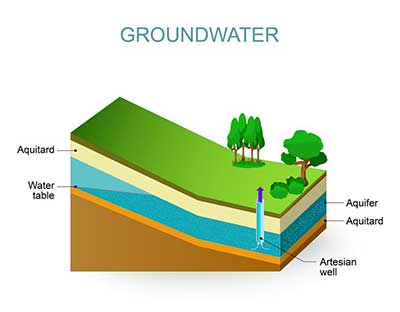Relevance: GS-3: Conservation, environmental pollution and degradation.
Key Phrases: Jal Shakti ministry, Groundwater aquifers, Central Groundwater Board, NITI Aayog’s, Composite Water Management Index, water user charges, Araniyar and Korattailaiyar River, Netherlands, Central Groundwater Board
Why in News?
- Recently in Tamil Nadu, due to lack of fresh water availability to recharge groundwater and sea water intrusion has made soil infertile for growing crops causing distress among the farming communities.
- The Central government plans to recharge groundwater using treated water in a novel bid to alleviate water shortages in Tamil Nadu.
- If the pilot proves to be successful, the method is likely to be replicated in other parts of the country as well.
Background:
- Lack of fresh water to recharge groundwater is a problem in large parts of Tamil Nadu where saline sea water has seeped into the soil, making it infertile.
- The artificial recharge project is being implemented in collaboration and coordination between the Netherlands and the Jal Shakti ministry.
- The pilot project being implemented in the doab of Araniyar and Korattailaiyar River in Tamil Nadu is an innovative solution. Doab refers to the alluvial land between two converging rivers.
Need:
- Artificial recharge is the simple solution to polluted Groundwater
aquifers :
- In India, direct recharge using treated water has not been taken up considering that groundwater is used for all purposes, including drinking.
- However, many areas have already been affected by seawater intrusion and groundwater is already saline.
- Considering the poor quality of groundwater, it would be apt to carry out a pilot study in these areas and understand the impact through vigorous monitoring and based on the results, the same can be replicated in other areas having similar problems.
- India moving towards water-stressed to water-scarcity nation:
- According to a 2018 estimate by Niti Aayog, 600 million people in India face high to extreme water stress, and about 200,000 people die every year owing to inadequate access to safe water, a crisis that is set to get worse.
- The water situation in states such as Rajasthan, UP, and Gujarat, too, is worrisome as per government estimates.
- Increasing mismatches between demand and supply of water:
- Niti Aayog also projected that by 2030, India’s water demand will be twice the available supply.
- The policy think tank brought out a composite water management index in 2019 which ranked Gujarat as the best performer in 2016-17 and Jharkhand the worst.
- It has also projected that India’s water requirement by 2050 in a high use scenario is likely to be 1,180 billion cu. m (BCM) while availability is likely to be lower at 1,137 BCM.
- Adopt successful models:
- The artificial way to purify the polluted surface water is to treat it and then discharge it into groundwater, is cost effective and efficient too.
- The Netherlands government and their NGOs have been focusing on reducing the cost of water treatment and amplifying the benefits and success in groundwater recharge with an adequate knowledge of geological conditions.
- Huge scarcity of natural fresh water:
- An attempt was made earlier by the Tamil Nadu government to push the seawater interface towards the sea by injecting fresh water into the aquifer but this was discontinued due to non-availability of freshwater sources.
- The Central Ground Water Board’s simulation has suggested a possibility of positive impact of the artificial recharge in ground water availability in Tamil Nadu.
Way Forward:
- Considering the groundwater availability issues, demands should be fixed according to the supply of water.
- Implementation of water user charges that can strengthen the capacity of local bodies.
- Of the total 6,965 blocks assessed by Central Groundwater Board, the groundwater condition in 2,529 blocks is stressful, thus should be considered for artificial recharge.
- Micro-irrigation (drip and sprinkler), which can save about 50 per cent of water in the cultivation of different crops, should be promoted in the over-exploited blocks to reduce the exploitation of groundwater.
- Importantly, as underlined in the groundwater report released by the United Nations, people from all walks of life must continue to be made aware of water literacy and on the hazardous effects of rapidly declining groundwater.
Source: Live-Mint
Mains Question:
Q. What do you understand from Artificial Recharge of Groundwater? Critically examine the impact of artificial recharge of groundwater on the water availability and groundwater replenishment across India with special reference to coastal regions. (15 marks).









